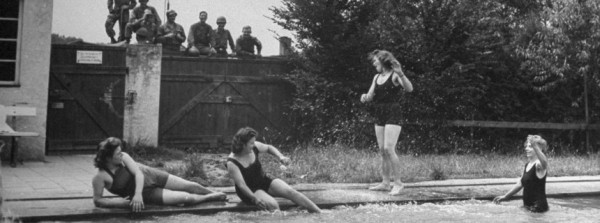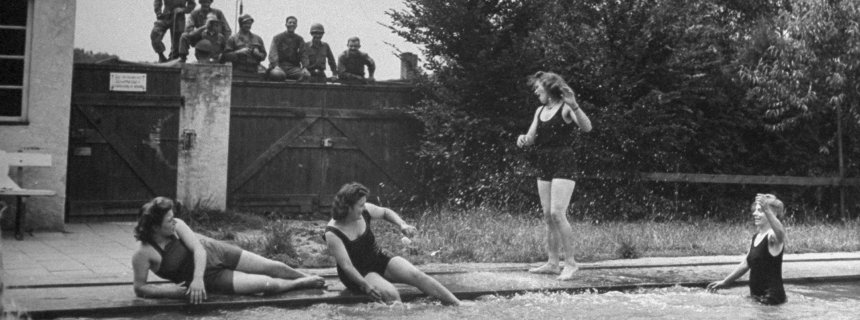
Fraternization of American troops with German civilians; GI’s watching girls swimming. (Photo by Ralph Morse/The LIFE Picture Collection/Getty Images)
In the popular imagination, American GIs in postwar Germany were well-liked and well-behaved. But a new book claims that US soldiers raped up to 190,000 women at the end of World War II. Is there any truth to the controversial claim?
The soldiers arrived at dusk. They forced their way into the house and tried to drag the two women upstairs. But Katherine W. and her 18-year-old daughter Charlotte were able to escape.
The soldiers didn’t give up easily though. They began searching all the houses in the area and ultimately found the two women in a neighbor’s closet shortly before midnight. The men pulled them out and threw them onto two beds. The crime the six soldiers ultimately committed took place in March, 1945, shortly before the end of World War II. The girl cried for help: “Mama. Mama.” But none arrived.
Hundreds of thousands, perhaps millions, of German women experienced a similar fate at the time. Often, such gang rapes were blamed on Soviet troops in Germany’s east. But this case was different. The rapists were soldiers from the United States of America and the crime took place in Sprendlingen, a village near the Rhine River in the west.
By the end of the war, some 1.6 million American troops had advanced deep into Germany, ultimately meeting the advancing Soviets at the Elbe River. In the US, those who freed Europe from the plague of the Nazis came to be known as the “Greatest Generation.” And Germans too developed a positive image of their occupiers: cool soldiers who handed out chewing gum to the children and wowed the German fräuleins with jazz and nylons.
But is that image consistent with reality? German historian Miriam Gebhardt, well known in Germany for her book about leading feminist Alice Schwarzer and the feminist movement, has now published a new volume casting doubt on the accepted version of America’s role in German postwar history.
Reports from the Catholic Archive
The work, which came out in German on Monday, takes a closer look at the rape of German women by all four victorious powers at the end of World War II. In particular, though, her views on the behavior of American GIs are likely to raise eyebrows. Gebhardt believes that members of the US military raped as many as 190,000 German women by the time West Germany regained sovereignty in 1955, with most of the assaults taking place in the months immediately following the US invasion of Nazi Germany.
The author bases her claims in large part on reports kept by Bavarian priests in the summer of 1945. The Archbishop of Munich and Freising had asked Catholic clergy to keep records on the allied advance and the Archdiocese published excerpts from its archive a few years ago.
Michael Merxmüller, a priest in the village of Ramsau near Berchtesgaden, wrote on July 20, 1945, for example: “Eight girls and women raped, some of them in front of their parents.”
Father Andreas Weingand, from Haag an der Amper, a tiny village located just north of where the Munich airport is today, wrote on July 25, 1945: “The saddest event during the advance were three rapes, one on a married woman, one on a single woman and one on a spotless girl of 16-and-a-half. They were committed by heavily drunken Americans.”
Father Alois Schiml from Moosburg wrote on Aug. 1, 1945: “By order of the military government, a list of all residents and their ages must be nailed to the door of each house. The results of this decree are not difficult to imagine. … Seventeen girls or women … were brought to the hospital, having been sexually abused once or several times.”
The youngest victim mentioned in the reports is a seven-year-old child. The oldest, a woman of 69.
Macho Fantasies
The reports led book author Gebhardt to compare the behavior of the US army with the violent excesses perpetrated by the Red Army in the eastern half of the country, where brutality, gang rapes and incidents of looting have dominated the public perception of the Soviet occupation. Gebhardt, however, says that the rapes committed in Upper Bavaria show that things weren’t much different in postwar Germany’s south and west.
The historian also believes that similar motives were at work. Just like their Red Army counterparts, the US soldiers, she believes, were horrified by the crimes committed by the Germans, embittered by their pointless and deadly efforts to defend the country to the very end, and furious at the relatively high degree of prosperity in the country. Furthermore, propaganda at the time conveyed the idea that German women were attracted to American GIs, further fueling macho fantasies.
Gebhardt’s ideas are firmly rooted in the current academic mainstream. In the wake of the torture scandal at Abu Ghraib and other war crimes committed by US soldiers in Iraq and Afghanistan, many historians are taking a more critical look at the behavior of the American military during the days immediately preceding and following the end of World War II in Germany. Studies in recent years have shed light on incidents involving GIs plundering churches, murdering Italian civilians, killing German prisoners of war and raping women, even as they advanced across France.
Despite such findings, the Americans are still considered to have been relatively disciplined compared to the Red Army and the French military — conventional wisdom that Gebhardt is hoping to challenge. Still, all of the reports compiled by the Catholic Church in Bavaria only add up to a few hundred cases. Furthermore, the clergymen often praised the “very correct and respectable” behavior of the US troops. Their reports make it seem as though sexual abuse committed by the Americans was more the exception than the rule.
How, then, did the historian arrive at her shocking figure of 190,000 rapes?
Sufficient Evidence?
The total is not the result of deep research in archives across the country. Rather, it is an extrapolation. Gebhardt makes the assumption that 5 percent of the “war children” born to unmarried women in West Germany and West Berlin by the mid-1950s were the product of rape. That makes for a total of 1,900 children of American fathers. Gebhardt further assumes that on average, there are 100 incidents of rape for each birth. The result she arrives at is thus 190,000 victims.
Such a total, though, hardly seems plausible. Were the number really that high, it is almost certain that there would be more reports on rape in the files of hospitals or health authorities, or that there would be more eyewitness reports. Gebhardt is unable to present such evidence in sufficient quantity.
Another estimate, stemming from US criminology professor Robert Lilly, who examined rape cases prosecuted by American military courts, arrived at a number of 11,000 serious sexual assaults committed by November, 1945 — a disgusting number in its own right.
But Gebhardt is certainly correct on one point: For far too long, historical research has been dominated by the idea that rapes committed by GIs were implausible because German women wanted to jump into bed with them anyway.
How, though, is one to interpret the complaint filed by a hotelier in Munich on May 31, 1945? She reports that US soldiers had commandeered a few rooms and that four women were “running around completely naked” and were “exchanged several times.” Was it really voluntary?
Even if it isn’t likely that the Americans committed 190,000 sexual crimes, it remains true that for postwar victims of rape — which was undeniably a mass phenomenon at the end of World War II, there is “no culture of memory, no public recognition, much less an apology” from the perpetrators, Gebhardt notes. And today, 70 years after the end of the war, it unfortunately doesn’t look as though that situation will soon change.
Read More











Sign up on lukeunfiltered.com or to check out our store on thebestpoliticalshirts.com.